New York City Subway line
| BMT Astoria Line | |||
|---|---|---|---|
  The N and W train services use the entire BMT Astoria Line. The N and W train services use the entire BMT Astoria Line. | |||
| Overview | |||
| Owner | City of New York | ||
| Termini | |||
| Stations | 7 | ||
| Service | |||
| Type | Rapid transit | ||
| System | New York City Subway | ||
| Operator(s) | New York City Transit Authority | ||
| Daily ridership | 47,522 | ||
| History | |||
| Opened | 1917 | ||
| Technical | |||
| Number of tracks | 2-3 | ||
| Character | Elevated | ||
| Track gauge | 4 ft 8+1⁄2 in (1,435 mm) | ||
| Electrification | 600V DC third rail | ||
| |||
The BMT Astoria Line (formerly the IRT Astoria Line) is a rapid transit line in the B Division of the New York City Subway, serving the Queens neighborhood of Astoria. It runs south from Ditmars Boulevard in Astoria to 39th Avenue in Long Island City above 31st Street. It then turns west and serves Queensboro Plaza over Queens Plaza.
The entire line is served by the N train at all times, joined by the W train only on weekdays during the day. It was built as part of the Dual Contracts and jointly operated by the Interborough Rapid Transit Company (IRT) and Brooklyn–Manhattan Transit Corporation (BMT) using IRT-sized cars until 1949, when the platforms were shaved to accept the wider BMT cars and joint service was discontinued.
Description and service
All services make all stops on the BMT Astoria Line.
| Time period | ||
|---|---|---|
| Weekdays | Late nights and weekends | |
| full line | ||
| full line | no service | |
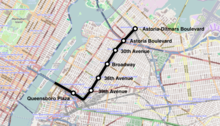
The north end of the Astoria Line is a two-track terminal at Ditmars Boulevard, with one island platform. South of the station, the center express track, currently not used in revenue service, begins (with crossovers to allow terminating trains to reach the correct track). The next station, Astoria Boulevard, is the only express station on the three-track section. The next four stations are local ones with two side platforms.
South of 39th Avenue, the express track merges with the two outer tracks. The line then curves west and enters Queensboro Plaza, a dual-level station with northbound trains on the upper level, southbound trains on the lower level, and cross-platform transfers to the IRT Flushing Line. Crossover tracks exist between the upper-level tracks just north of the station, one of a few connections between the BMT / IND and IRT. After Queensboro Plaza, the line ramps underground, and merges with the 60th Street Tunnel Connection to become the BMT Broadway Line via the 60th Street Tunnel to Manhattan.
History
Opening

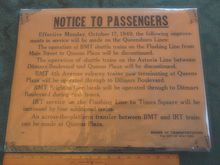
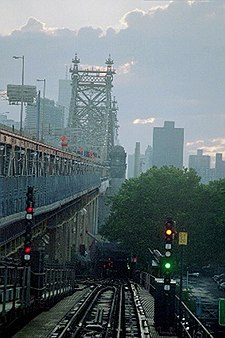
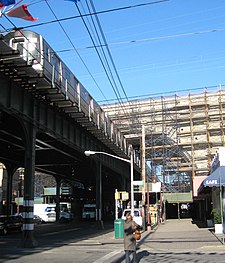
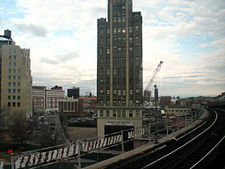
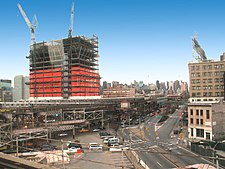
The Astoria Line was originally part of the Second Avenue Elevated Line, eventually purchased by the Interborough Rapid Transit Company (IRT). Manhattan-bound trains went over the 59th Street (Queensboro) Bridge, then turned south on Second Avenue, joining up with the main line of the Second Avenue Elevated to City Hall and South Ferry. Later the Astoria line was made a spur off the IRT Queensboro Line, now the IRT Flushing Line. The whole line north of Queensboro Plaza opened on February 1, 1917 and was used by trains between Grand Central and Astoria. Through IRT service to the Corona Line (now the Flushing Line) began two months later on April 21.
On July 23, 1917, the Queensboro Bridge spur of the elevated IRT Second Avenue Line opened. At that time, all elevated trains to Queensboro Plaza used the Astoria Line while all subway trains used the Corona Line, though this was later changed with trains alternating between branches.
The 60th Street Tunnel opened on August 1, 1920, allowing BMT trains to reach Queensboro Plaza. However, the stations on the Astoria and Corona Lines were built to IRT specifications, whose platforms were too wide for BMT rolling stock. As a result, those trains terminated at Queensboro Plaza using a relay track east of the station to reverse direction for the return trip to Manhattan.
On April 8, 1923, the BMT, using elevated cars, started running shuttles along the Astoria (numbered BMT 8 in 1924) and Corona Lines (BMT 9) in addition to the existing IRT service. On June 23, 1942, the IRT Second Avenue Line spur to Queensboro Plaza closed.
The IRT services were numbered in 1948, with 7 being assigned to the Flushing Line and 8 to the Astoria Line.
Modifications
On July 24, 1949, through service between the Astoria Line and the IRT Times Square station was discontinued. On October 17, 1949, the Flushing Line became IRT-only. The platforms on the Astoria Line were shaved back to allow through BMT trains to operate on it, the first ones being the Brighton Local (BMT 1) weekdays & Broadway - Fourth Avenue Local (BMT 2) at all times. Since then, the Astoria Line has hosted the northern end of various services running from Brooklyn through Manhattan; see B, N, Q, R, T and W for details.
The platforms at the seven stations on the Astoria Line were lengthened to 610 feet (190 m) to accommodate ten-car (60') trains in 1950. The project cost $863,000. Signals on the line had to be modified to take into account the platform extensions.
As part of an 18-month capital budget that took effect on January 1, 1963, the wooden platforms at the stations on the Astoria Line were replaced with concrete platforms.
The 2015–2019 MTA Capital Plan called for the Astoria Line's 30th Avenue, Broadway, 36th Avenue, and 39th Avenue stations, along with 29 others, to undergo a complete overhaul as part of the Enhanced Station Initiative. Updates included cellular service, Wi-Fi, USB charging stations, interactive service advisories and maps, improved signage, and improved station lighting. The 30th and 36th Avenues stations were renovated first, from October 2017 to June 2018. After these two stations were reopened, the Broadway and 39th Avenue stations were renovated from July 2018 to January 2019. The remaining stations on the line, Astoria Boulevard and Astoria-Ditmars Boulevard, are also simultaneously undergoing renovations. Astoria-Ditmars Boulevard was renovated from April 2018 to June 2019 and would remain open during this time. However, the Astoria Boulevard station was closed from March 2019 until late 2019. Astoria Boulevard's mezzanine was torn down and replaced, and elevators were added at the station.
Extension proposals
A 1920s Transit Commission study proposed extending the line northwest across or under Randalls and Wards Islands back into Manhattan as a crosstown line at 125th Street, roughly following the route of what is now the Triborough Bridge. As part of the IND Second System plan from 1929, the BMT/IRT Astoria Line would be extended east via Ditmars Boulevard, Astoria Boulevard, 112th Street, and Nassau Boulevard (today's Long Island Expressway) terminating at Cross Island Boulevard. The new line that would have been an extension of the Astoria Line would be called the Long Island City-Horace Harding Boulevard Line. The line would have been 2 tracks to Astoria Boulevard, and afterward, it would become a 4 track line before going back to 2 tracks at Parsons Boulevard. The entire line would be elevated except for a short section which would have been depressed under Nassau Boulevard. The line would have been extended 8.1 miles at a cost of $17.7 million.
In 1998, an extension of the BMT Astoria Line to LaGuardia Airport was planned as part of a $1.2 billion package to provide access to the New York City airports with funding from the MTA, the Port Authority and the city. The preferred route would have extended the Astoria Line along 31st Street north onto Con Edison's property at the edge of Astoria and then east along 19th Avenue to the Marine Air Terminal. The MTA also considered an eastward extension along Ditmars Boulevard, and a plan to reroute LaGuardia-bound trains from Queensboro Plaza through the Sunnyside rail yard and along the eastern edge of St. Michael’s Cemetery to elevated tracks parallel to the Grand Central Parkway. A fourth route was to have trains turn east via Astoria Boulevard. All of the options would have new elevated sections built. $645 million for the LaGuardia extension was included in the MTA's 2000–2004 Five-Year Capital Plan, and in late 2002, Mayor Bloomberg supported the extension. These options were studied in the LaGuardia Airport Subway Access Study. Community opposition was strong and therefore the plan was canceled in July 2003; however, as of 2021, it is being reconsidered after New York governor Kathy Hochul requested the Port Authority find alternatives to the AirTrain LaGuardia project.
The Regional Plan Association, in its Fourth Plan in 2017, anticipated that the population of Astoria would quickly grow over the next three decades, and so called for the Astoria Line to be extended to a new storage yard at Ditmars Boulevard and 20th Street, which would provide added capacity. In addition, a new station at 21st Avenue and 20th Street would improve access for the currently underserved but dense northwest parts of Astoria.
Station listing
| Station service legend | |
|---|---|
| Stops all times | |
| Stops all times except late nights | |
| Stops weekdays during the day | |
| Stops rush hours in the peak direction only | |
| Time period details | |
| Station is compliant with the Americans with Disabilities Act | |
| Station is compliant with the Americans with Disabilities Act in the indicated direction only | |
| Elevator access to mezzanine only | |
| Neighborhood (approximate) |
Station | Tracks | Services | Opened | Transfers and notes | |
|---|---|---|---|---|---|---|
| Astoria | Astoria–Ditmars Boulevard | N W | February 1, 1917 | originally Ditmars Avenue | ||
| Center Express track begins (No Regular Service) | ||||||
| Astoria Boulevard | all | N W | February 1, 1917 | originally Hoyt Avenue M60 Select Bus Service to LaGuardia Airport | ||
| 30th Avenue | local | N W | February 1, 1917 | originally Grand Avenue | ||
| Broadway | local | N W | February 1, 1917 | |||
| 36th Avenue | local | N W | February 1, 1917 | originally Washington Avenue | ||
| Long Island City | 39th Avenue | local | N W | February 1, 1917 | originally Beebe Avenue Also known as Dutch Kills | |
| Center Express track ends | ||||||
| connecting tracks to IRT Flushing Line (No regular service) | ||||||
| Queensboro Plaza | all | N W | February 1, 1917 | 7 <7> (IRT Flushing Line) | ||
| merges with the 60th Street Tunnel Connection (R ) and becomes the BMT Broadway Line via the 60th Street Tunnel (N R W ) | ||||||
References
- "Annual Subway Ridership (2018–2023)". Metropolitan Transportation Authority. 2023. Retrieved April 20, 2024.
- ^ "N Subway Timetable, Effective December 15, 2024". Metropolitan Transportation Authority. Retrieved December 16, 2024.
- ^ "W Subway Timetable, Effective December 15, 2024". Metropolitan Transportation Authority. Retrieved December 16, 2024.
- "Subway Service Guide" (PDF). Metropolitan Transportation Authority. September 2019. Retrieved September 22, 2019.
- ^ Dougherty, Peter (2006) . Tracks of the New York City Subway 2006 (3rd ed.). Dougherty. OCLC 49777633 – via Google Books.
- ^ "First Train Runs On Elevated Line to Astoria Section". Brooklyn Daily Eagle. February 1, 1917. Retrieved June 29, 2015 – via Newspapers.com.
- ^ 1916-1917 Annual Report of the Interborough Rapid Transit Company For The Year June 30, 1917. Interborough Rapid Transit Company. 1917. p. 21.
- "New Astoria Line Opened". The New York Times. February 2, 1917. p. 14. ISSN 0362-4331. Retrieved December 18, 2011.
- "Subway Link Over Queensboro Bridge". The New York Times. July 22, 1917. p. 31. ISSN 0362-4331. Retrieved December 18, 2011.
- "New Subway Link Opens". The New York Times. August 1, 1920. p. 12. ISSN 0362-4331. Retrieved December 18, 2011.
- "Additional Subway Service to Borough of Queens". The New York Times. April 8, 1923. p. RE1. ISSN 0362-4331. Retrieved December 18, 2011.
- "Astoria Line Change". New York Daily News. July 15, 1949. Retrieved November 5, 2018.
- "Direct Subway Runs to Flushing, Astoria". The New York Times. October 15, 1949. p. 17. ISSN 0362-4331. Retrieved December 18, 2011.
- Bulletin. General Contractors Association. 1950. p. 23.
- Proceedings of the Board of Transportation of The City of New York. New York City Board of Transportation. 1950. pp. 432, 729.
- "For Release Sunday, July 12, 1964" (PDF). New York City Office of the Mayor. July 12, 1964. Retrieved August 28, 2019.
- Whitford, Emma (January 8, 2016). "MTA Will Completely Close 30 Subway Stations For Months-Long "Revamp"". Gothamist. Archived from the original on August 1, 2016. Retrieved July 18, 2016.
- "MTAStations" (PDF). governor.ny.gov. Government of the State of New York. Retrieved July 18, 2016.
- ^ "Broadway & 39 Av NW Stations to Undergo Extensive Repairs & Renovations". mta.info. June 8, 2018. Archived from the original on June 12, 2018. Retrieved June 17, 2018.
- "Proposed Additions to Rapid Transit System to Cost $218,000,000". New York State Transit Commission. 1922. Retrieved August 1, 2019 – via nycsubway.org.
- 100 Miles of Subway in New City Project; 52 of them in Queens, The New York Times September 16, 1929, p. 1. Retrieved June 11, 2014
- nycsubway.org—IND Second System – 1929 Plan
- Roess, Roger P.; Sansone, Gene (August 23, 2012). The Wheels That Drove New York: A History of the New York City Transit System. Springer Science & Business Media. ISBN 9783642304842.
- "Dreams of taking the N to LaGuardia". Second Ave. Sagas. January 19, 2010. Retrieved May 1, 2016.
- "Second Avenue Subway Supplemental Draft Environmental Impact Statement (SDEIS), April 2003 Appendix A Planning Context" (PDF). mta.info. Metropolitan Transportation Authority. April 2003. Retrieved August 9, 2016.
- Toscano, John (July 16, 2003). "N Train Extension To LaG Scrapped". Queens Gazette. Archived from the original on May 25, 2009. Retrieved July 26, 2009.
- "Flashback To 1999". www.qgazette.com. June 27, 2007. Archived from the original on March 22, 2016. Retrieved March 25, 2014.
- Guse, Clayton (November 16, 2021). "Port Authority brings in MTA, transit experts to reexamine subway extension to LaGuardia Airport". New York Daily News.
- "Fourth Regional Plan - Regional Plan Association". Regional Plan Association. November 2017. Retrieved January 22, 2022.
External links
KML file (edit • help) Template:Attached KML/BMT Astoria LineKML is from Wikidata![]() Media related to BMT Astoria Line at Wikimedia Commons
Media related to BMT Astoria Line at Wikimedia Commons
| New York City Subway lines | |||||||||||||||||||||||||
|---|---|---|---|---|---|---|---|---|---|---|---|---|---|---|---|---|---|---|---|---|---|---|---|---|---|
| A Division |
| ||||||||||||||||||||||||
| B Division |
| ||||||||||||||||||||||||
| Interdivision connections |
| ||||||||||||||||||||||||
| Other | |||||||||||||||||||||||||
| Note that this is a list of New York City Subway lines, which are the physical infrastructure over which services operate. Lines with colors next to them are trunk lines; trunk lines determine the color of New York City Subway service bullets, except for shuttles, which are dark gray. | |||||||||||||||||||||||||
| New York City Subway | |||||||||||||
|---|---|---|---|---|---|---|---|---|---|---|---|---|---|
| Current services |
| ||||||||||||
| Defunct services |
| ||||||||||||
| Stations (List) |
| ||||||||||||
| Divisions | |||||||||||||
| Other lists | |||||||||||||
| History |
| ||||||||||||
| Infrastructure | |||||||||||||
| Arts and culture | |||||||||||||
| Miscellaneous | |||||||||||||
| Other rapid transit in NYC |
| ||||||||||||
| Stations of the New York City Subway, by line (physical trackage) | |
|---|---|
| Astoria Line | |
| |